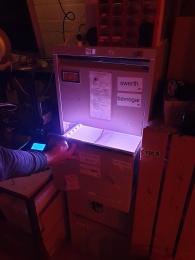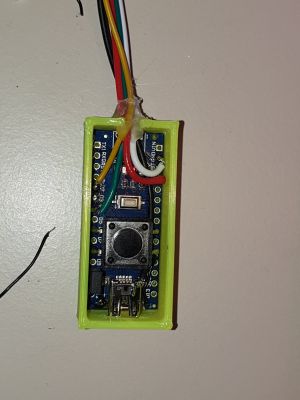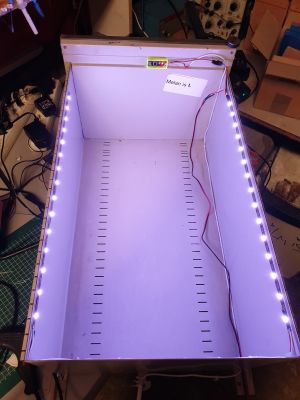LaLamp: Difference between revisions
(Created page with "{{Project |Name=LaLamp |Skills=Soldering, Programming, |Status=Active as fuck |Niche=Artsy stuff |Purpose=Tool |Picture=LaLamp.jpg |Tool=No }} File:Drawer microcontroller.jp...") |
No edit summary |
||
| Line 29: | Line 29: | ||
== Firmware == | == Firmware == | ||
The firmware is pretty simple as well, once it detects the drawer has been opened it will first play an animation and then just go to full white. There's a button on the MCU that allows to switch between modes. I still want to change some of the modes, and make the opening animation slower. Luckily the MCU and it's USB port is easily accessible. And not many can say they need to update their | The firmware is pretty simple as well, once it detects the drawer has been opened it will first play an animation and then just go to full white. There's a button on the MCU that allows to switch between modes. I still want to change some of the modes, and make the opening animation slower. Luckily the MCU and it's USB port is easily accessible. And not many can say they need to update their drawers firmware! | ||
== Parts == | == Parts == | ||
* Arduino Nano (clone) | * Arduino Nano (clone) | ||
* 30 ws812b leds | * 30 ws812b leds | ||
* 3D printed case for the Arduino: https://www.thingiverse.com/thing:3576631 | |||
* | == Todo == | ||
* Put updated code on Github | |||
* Look into adding a small layer of diffusion over the led strips | |||
Revision as of 14:35, 24 February 2020
| LaLamp | |
|---|---|
| Participants | Melan |
| Skills | Soldering, Programming |
| Status | Active as fuck |
| Niche | Artsy stuff |
| Purpose | Tool |
| Tool | No |
| Location | |
| Cost | |
| Tool category | |
LaLamp.jpg {{#if:No | [[Tool Owner::{{{ProjectParticipants}}} | }} {{#if:No | [[Tool Cost::{{{Cost}}} | }}
What
My drawer is located near the 3D printers, which is a pretty dark corner making it harder to look in my drawer. My first attempt to circumvent this was to place a led light on top of the drawer, but that was more cumbersome. However, user:buzz came with the genius idea of just putting lights in the drawer it self. So I decide to make this idea an reality.
My first idea was to make it battery operated, I managed to make an Arduino Pro Micro go into sleep mode using only a few Milli-amps, power usage was even more reduced after I had a mosfet take away power to the entire led strip (they are addressable leds, meaning they all have a tiny MCU in them that still draws power).
However, eventually I decided against the idea of making it battery powered because the ledstrip at max brightness would pull about 1.8A, which I wasn't really comfortable with using batteries for. In the end I settled for a Arduino nano clone.
(La = Drawer, lamp = light)
Power
The whole thing is running of a 5V 2A wall-wart, when the lights are off the whole she-bang draws about 40mV.
Mechanics
The mechanics of detecting if the drawer is open or closed is pretty damn simple, it uses a reed switch at the back of the drawer and a magnet against the back of the closet (Thanks for the idea user:Zarya!). There's a small hole drilled at the side of the closet to allow for power to be routed and so that the cable doesn't get cached up by the drawer it self. To see how long the wiring last remains to be seen.
Firmware
The firmware is pretty simple as well, once it detects the drawer has been opened it will first play an animation and then just go to full white. There's a button on the MCU that allows to switch between modes. I still want to change some of the modes, and make the opening animation slower. Luckily the MCU and it's USB port is easily accessible. And not many can say they need to update their drawers firmware!
Parts
- Arduino Nano (clone)
- 30 ws812b leds
- 3D printed case for the Arduino: https://www.thingiverse.com/thing:3576631
Todo
- Put updated code on Github
- Look into adding a small layer of diffusion over the led strips


